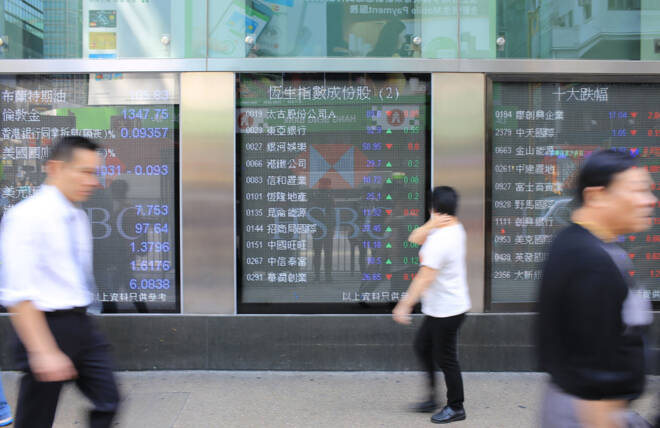Advertisement
Advertisement
Hang Seng Index, Nikkei 225, ASX 200: Caixin Manufacturing PMI Drops Below 50
By:
Key Points:
- On Thursday, August 1, the Nikkei slumped on Bank of Japan and Fed policy decisions.
- Manufacturing sector PMI numbers from China added to the gloomy mood, sending the Mainland China Indexes into the red.
- The ASX 200 and Hang Seng Index bucked the negative trend on rising expectations of Fed rate cuts.
Nasdaq Soars on Nvidia Boost Amid Fed Speculation.
On Wednesday, July 31, the US equity markets ended July on a high note. The Nasdaq Composite Index and the S&P 500 rallied 2.64% and 1.58%, respectively, while the Dow gained 0.24%.
One of the Wednesday highlights was Morgan Stanley upgrading Nvidia (NVDA), driving demand for tech stocks after the recent rout. Nvidia ended the Wednesday session up by 12.81%.
The upgrade coincided with the FOMC interest rate decision and press conference, creating a ripe backdrop for the bulls.
Fed Chair Powell Delivers a Dovish Press Conference
On Wednesday, the Fed held interest rates , spotlighting the highly anticipated FOMC press conference.
Fed Chair Powell delivered a dovish press conference, noting that a September rate cut could be on the table if data meets expectations. Powell also commented on the US labor market, stating that labor market conditions should not deteriorate further.
The dovish comments fueled speculation about multiple 2024 Fed rate cuts. According to the CME FedWatch Tool, the chances of the 50 basis points December rate cut rose from 55.6% to 59.4%.
Expert Commentary
Wall Street Journal Chief Economics Correspondent Nick Timiraos commented on the FOMC press conference, stating,
“The bar to cut in September seems quite low based on everything Powell said at the presser. […]. A July cut was debated, but there was broad support to wait until September.”
China Manufacturing PMI Disappoints
The all-important China Caixin Manufacturing PMI drew investor interest on Thursday, August 1. The Caixin Manufacturing PMI fell from 51.8 in June to 49.8 in July, the sector contracting for the first time since October 2023.
Following growth of 4.7% in Q2 2024, the latest PMI numbers signaled more pain ahead, barring a fiscal stimulus package.
Caixin Insight Group Senior Economist Dr. Wang Zhe commented on the July PMI, stating,
“The most prominent issues are still insufficient effective domestic demand and weak market optimism. Therefore, policy efforts should focus on stabilizing growth, improving employment, safeguarding people’s livelihoods, intensifying policy stimulus, ensuring effective implementation of previous policies, and unleashing market vitality.”
Hang Seng and Mainland China Markets Have Mixed Morning
Meanwhile, the Hang Seng Index rose by 0.09% on Thursday morning despite the Caixin Manufacturing PMI. The more dovish FOMC press conference and hopes of fiscal stimulus from Beijing countered the data from China.
Nevertheless, tech stocks had a mixed Thursday morning as the Hang Seng Tech (HSTECH) Index fell by 0.89%. Tencent (0700) advanced by 0.55%, while Alibaba (9988) and Baidu (9888) saw losses of 0.19% and 2.28%, respectively.
The Hang Seng Mainland Properties Index (HSMPI) was down 1.76%.
Mainland China equity markets saw their recovery stall. The CSI 300 declined by 0.28%, while the Shenzhen Composite Index fell by 0.68%.
Nikkei Index Slides on BoJ Rate Hike Threats
The Nikkei Index tumbled 3.23% on Thursday morning. Investors reacted further to the Bank of Japan monetary policy decision and forward guidance. Threats of more rate hikes and a stronger Yen impacted buyer demand for Nikkei-listed stocks. On Wednesday, the USD/JPY slid by 1.83% to 149.951, and extended its losses on Thursday.
Softbank Group Corp. (9984) slid by 5.71%, while Sony Corp. (6758) declined by 3.44%. Tokyo Electron Ltd. (8035) was down by 1.13%.
ASX 200 Tracks the US Equity Markets Higher
The ASX 200 Index advanced by 0.43% on Thursday morning. Gold, mining, oil, and tech stocks contributed to the gains. Gold and oil prices trended higher on Wednesday. The S&P ASX All Technology Index (XTX) rose by 0.81%.
Mining giants BHP Group Ltd (BHP) and Rio Tinto Ltd. (RIO) were up by 0.93% and 1.34%, respectively. Northern Star Resources Ltd. (NST) rallied 1.31%, while Woodside Energy Group Ltd (WDS) advanced by 1.34%.
Investors should remain alert with the Bank of Japan fallout and the Chinese economy in focus. Closely monitor the news wires, real-time data, and expert commentary to manage trading strategies accordingly. Stay informed with our latest news and analysis to manage positions across the Asian equity markets.
About the Author
Bob Masonauthor
With over 28 years of experience in the financial industry, Bob has worked with various global rating agencies and multinational banks. Currently he is covering currencies, commodities, alternative asset classes and global equities, focusing mostly on European and Asian markets.
Advertisement
